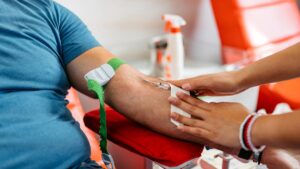Why haven’t any ASX pot stocks got CBD on Australian pharmacy shelves yet? And when will we see them?

Pic: Oscar Wong / Moment via Getty Images
Just where are all the CBD products that investors last year were promised would hit pharmacies across Australia?
But why aren’t we seeing the promised boom in 2021? And when will we see it?
It’s certainly the case that medicinal cannabis more broadly is having a bumper year. In 2021, total product revenues are on track to exceed $200 million and active patients are at 60,000 according to Freshleaf Analytics.
In contrast, 2020 ended with just over 35,000 active patients and $100 million in product revenue.
But we are still yet to see CBD products on the shelves of Australian pharmacies, a prospect that excited investors but still eludes them.
Investors ‘jumped prematurely’
Two companies vying to be among the first to roll out CBD products are Cann Group (ASX:CAN) and Emyria (ASX:EMD).
Stockhead spoke with both companies about their perspective on the current situation.
They noted while the TGA declassification was an important step, it was not the only one that had to be taken for CBD products to appear in pharmacies across Australia.
Cann’s Peter Crock, who is also the boss of industry body the MCIA, admitted investors may have thought 2021 was the year, but they got ahead of themselves.
“I think after it was announced and came into effect on the 1st February [2021], yes people did jump on prematurely in terms of what they thought that would mean,” he said.
“There was a lot press coverage in February saying ‘Oh look there’s CBDs at pharmacies!””
“No, the pathway was open but the Schedule 3 process requires clinical trial work and a regulatory submission to be put together and submitted.”
To Crock’s knowledge, no company has a submission ready. Although plenty of companies are working on a submission, the TGA could take several months to review them once the case is made.
“Looking at timing, it’s going to be well into 2022 before we see anything through TGA process and available at pharmacies,” he said.
“[A] submission has to be off the back of a clinical trial and regulatory submission and before you can put a trial down you need ethics approval.
“There’s a whole series of steps companies will have to pass to get through the hurdles and get a product on the other side.”
What still needs to happen for CBD products to hit pharmacies in Australia?
Emryia’s Michael Winlo concurred, noting even companies that knew these requirements all along were finding it more difficult, for several reasons particular to the Schedule 3 classification.
“Two main considerations for Schedule 3 are that you need to have the right dose form, so you can’t have too much CBD and too much other stuff – and that’s been clearly spelt out by the TGA,” he said.
“But the other big decision a company needs to make is what indication to go for, what thing are you going to treat [and] what trial are you going to run to show that your CBD is effective and safe in a population?
“There’s certain things the TGA will allow and other things they won’t allow. You could never get it to treat something like cancer – it’s a serious decision requiring oversight and a formal diagnosis.
“You’re limited to conditions and symptoms that can be easily self-recognised and managed by a pharmacist. And I think that’s been daunting because that’s typically not the kind of patients that present for medicinal cannabis through SAS or prescriptions.”
Winlo said Emyria had an advantage as his company had been giving doses to a wide variety of patients, were giving CBD products only and at a strength relevant to Schedule 3.
But there were still challenges, one being the price paid by patients.
“Right now our patients are paying something between $250-$800 per month for 150mg or less,” he said.
“None of those are very attractive to someone behind the counter, especially if you consider the margin and you consider the margin a pharmacist needs to make and distributors too.
“We need to get the cost and dose form right and also pick the right implication then run the trial to show the drug is effective.”
Winlo had another curious observation about many of his industry peers.
“I think because many companies haven’t come from traditional drug development they’re having to learn as they go, which is one of the reasons we’re seeing this take longer than others had hoped,” he said.
“I think the expectations were high to start with, to be frank about how fast companies could get products to the shelves.”
Will it be worth the wait?
But Winlo says when CBD products come to pharmacies in Australia it will be worth the wait.
And also, that the first mover will be in a prestigious position.
“When they do become available, the ones to get there first will absolutely dominate because they’ll enjoy privileged positions for an extended period of time as others catch up,” he said.
“We would’ve liked to be underway sooner than we are but by the time we get going, I think we’re in line to be one of the first to register.”
Cann’s Peter Crock also said it’d be a big moment when CBD products came to Australian pharmacies.
“It’s going to be important step for the whole sector in terms of promoting and having CBD more prevalent and patients being able to go in and talk to pharmacists about it,” he said.
“That’s how a lot of [pharmaceutical] products are provided, with that interaction with pharmacists – they’ll be able to assist and it becomes a mainstream product line and not having to deal with complexities of SAS or authorised prescriber process.
“It means it’ll be more readily available for patients to use.”
Related Topics
UNLOCK INSIGHTS
Discover the untold stories of emerging ASX stocks.
Daily news and expert analysis, it's free to subscribe.
By proceeding, you confirm you understand that we handle personal information in accordance with our Privacy Policy.








